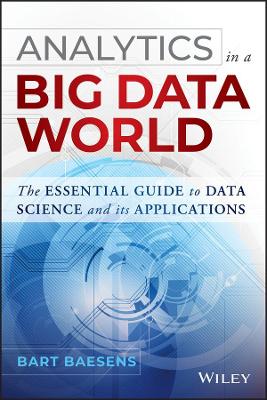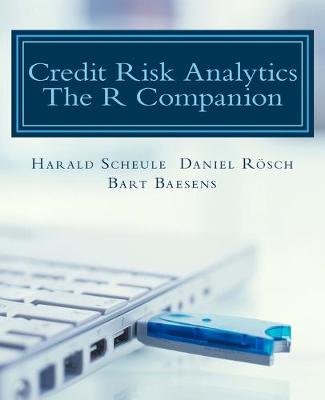Wiley and SAS Business
4 total works
Profit Driven Business Analytics
by Wouter Verbeke, Bart Baesens, and Cristian Bravo
Profit-Driven Business Analytics provides actionable guidance on optimizing the use of data to add value and drive better business. Combining theoretical and technical insights into daily operations and long-term strategy, this book acts as a development manual for practitioners seeking to conceive, develop, and manage advanced analytical models. Detailed discussion delves into the wide range of analytical approaches and modeling techniques that can help maximize business payoff, and the author team draws upon their recent research to share deep insight about optimal strategy. Real-life case studies and examples illustrate these techniques at work, and provide clear guidance for implementation in your own organization. From step-by-step instruction on data handling, to analytical fine-tuning, to evaluating results, this guide provides invaluable guidance for practitioners seeking to reap the advantages of true business analytics.
Despite widespread discussion surrounding the value of data in decision making, few businesses have adopted advanced analytic techniques in any meaningful way. This book shows you how to delve deeper into the data and discover what it can do for your business.
- Reinforce basic analytics to maximize profits
- Adopt the tools and techniques of successful integration
- Implement more advanced analytics with a value-centric approach
- Fine-tune analytical information to optimize business decisions
Both data stored and streamed has been increasing at an exponential rate, and failing to use it to the fullest advantage equates to leaving money on the table. From bolstering current efforts to implementing a full-scale analytics initiative, the vast majority of businesses will see greater profit by applying advanced methods. Profit-Driven Business Analytics provides a practical guidebook and reference for adopting real business analytics techniques.
Fraud Analytics Using Descriptive, Predictive, and Social Network Techniques
by Bart Baesens, Veronique Van Vlasselaer, and Wouter Verbeke
Fraud Analytics Using Descriptive, Predictive, and Social Network Techniques is an authoritative guidebook for setting up a comprehensive fraud detection analytics solution. Early detection is a key factor in mitigating fraud damage, but it involves more specialized techniques than detecting fraud at the more advanced stages. This invaluable guide details both the theory and technical aspects of these techniques, and provides expert insight into streamlining implementation. Coverage includes data gathering, preprocessing, model building, and post-implementation, with comprehensive guidance on various learning techniques and the data types utilized by each. These techniques are effective for fraud detection across industry boundaries, including applications in insurance fraud, credit card fraud, anti-money laundering, healthcare fraud, telecommunications fraud, click fraud, tax evasion, and more, giving you a highly practical framework for fraud prevention.
It is estimated that a typical organization loses about 5% of its revenue to fraud every year. More effective fraud detection is possible, and this book describes the various analytical techniques your organization must implement to put a stop to the revenue leak.
- Examine fraud patterns in historical data
- Utilize labeled, unlabeled, and networked data
- Detect fraud before the damage cascades
- Reduce losses, increase recovery, and tighten security
The longer fraud is allowed to go on, the more harm it causes. It expands exponentially, sending ripples of damage throughout the organization, and becomes more and more complex to track, stop, and reverse. Fraud prevention relies on early and effective fraud detection, enabled by the techniques discussed here. Fraud Analytics Using Descriptive, Predictive, and Social Network Techniques helps you stop fraud in its tracks, and eliminate the opportunities for future occurrence.
By leveraging big data & analytics, businesses create the potential to better understand, manage, and strategically exploiting the complex dynamics of customer behavior. Analytics in a Big Data World reveals how to tap into the powerful tool of data analytics to create a strategic advantage and identify new business opportunities. Designed to be an accessible resource, this essential book does not include exhaustive coverage of all analytical techniques, instead focusing on analytics techniques that really provide added value in business environments.
The book draws on author Bart Baesens' expertise on the topics of big data, analytics and its applications in e.g. credit risk, marketing, and fraud to provide a clear roadmap for organizations that want to use data analytics to their advantage, but need a good starting point. Baesens has conducted extensive research on big data, analytics, customer relationship management, web analytics, fraud detection, and credit risk management, and uses this experience to bring clarity to a complex topic.
- Includes numerous case studies on risk management, fraud detection, customer relationship management, and web analytics
- Offers the results of research and the author's personal experience in banking, retail, and government
- Contains an overview of the visionary ideas and current developments on the strategic use of analytics for business
- Covers the topic of data analytics in easy-to-understand terms without an undo emphasis on mathematics and the minutiae of statistical analysis
For organizations looking to enhance their capabilities via data analytics, this resource is the go-to reference for leveraging data to enhance business capabilities.
Credit Risk Analytics provides a targeted training guide for risk managers looking to efficiently build or validate in-house models for credit risk management. Combining theory with practice, this book walks you through the fundamentals of credit risk management and shows you how to implement these concepts using the SAS credit risk management program, with helpful code provided. Coverage includes data analysis and preprocessing, credit scoring; PD and LGD estimation and forecasting, low default portfolios, correlation modeling and estimation, validation, implementation of prudential regulation, stress testing of existing modeling concepts, and more, to provide a one-stop tutorial and reference for credit risk analytics. The companion website offers examples of both real and simulated credit portfolio data to help you more easily implement the concepts discussed, and the expert author team provides practical insight on this real-world intersection of finance, statistics, and analytics.
SAS is the preferred software for credit risk modeling due to its functionality and ability to process large amounts of data. This book shows you how to exploit the capabilities of this high-powered package to create clean, accurate credit risk management models.
Understand the general concepts of credit risk managementValidate and stress-test existing modelsAccess working examples based on both real and simulated dataLearn useful code for implementing and validating models in SASDespite the high demand for in-house models, there is little comprehensive training available; practitioners are left to comb through piece-meal resources, executive training courses, and consultancies to cobble together the information they need. This book ends the search by providing a comprehensive, focused resource backed by expert guidance. Credit Risk Analytics is the reference every risk manager needs to streamline the modeling process.



